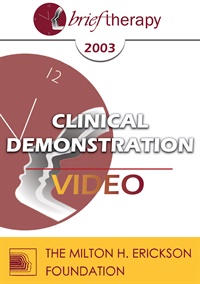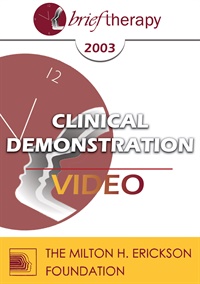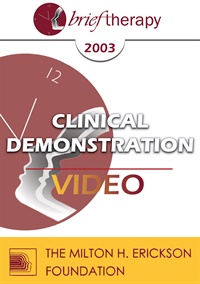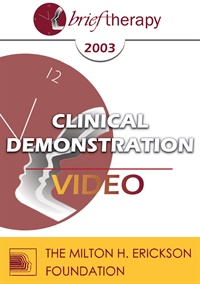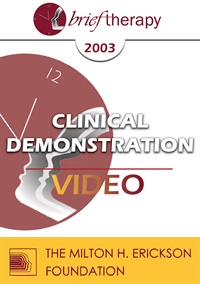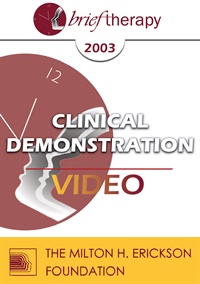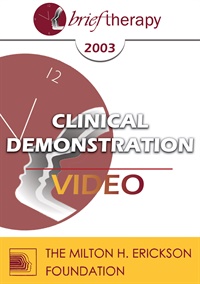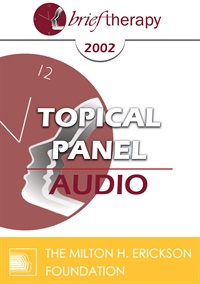
- Average Rating:
- Not yet rated
- Topic Areas:
- Topical Panels | Brief Therapy | Couples Therapy
- Categories:
- Brief Therapy Conference | Brief Therapy Conference 2002 | Pioneers in Couples and Family Therapy
- Faculty:
- Insoo Kim Berg, MSSW | Jon Carlson | Peggy Papp, ACSW
- Duration:
- 1:01:31
- Format:
- Audio Only
- Original Program Date:
- Dec 13, 2002
- Short Description:
- A discussion of effective brief therapy strategies for couples, highlighting solution-focused techniques like the miracle and scaling questions. The panel emphasizes understanding partners' belief systems, relationship themes, and personalized interventions. The conversation includes approaches for managing infidelity and preventing relapse by maintaining strong client engagement.
- Price:
- $15.00 - Base Price
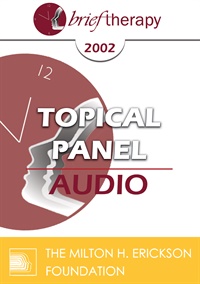
- Average Rating:
- Not yet rated
- Topic Areas:
- Topical Panels | Addiction | Brief Therapy
- Categories:
- Brief Therapy Conference | Brief Therapy Conference 2002
- Faculty:
- Steve De Shazer, MSSW | Robert Dilts, BA | Arthur Freeman, EdD
- Duration:
- 59:39
- Format:
- Audio Only
- Original Program Date:
- Dec 13, 2002
- Short Description:
- To describe the use of brief therapy techniques in specific clinical situations.
- Price:
- $15.00 - Base Price
Tags: Addiction Brief Therapy
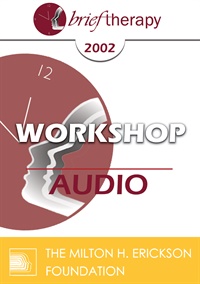
- Average Rating:
- Not yet rated
- Topic Areas:
- Workshops | Interviewing | Brief Therapy | Motivation | Therapeutic Relationship | Therapist Development
- Categories:
- Brief Therapy Conference | Brief Therapy Conference 2002
- Faculty:
- Steve De Shazer, MSSW
- Duration:
- 2:13:08
- Format:
- Audio Only
- Original Program Date:
- Dec 12, 2002
- Short Description:
- Skilled brief therapists just ask miracle questions or scaling questions. They must know how to ask questions in ways that do not undermine client motivation.
- Price:
- $15.00 - Base Price

- Average Rating:
- Not yet rated
- Topic Areas:
- Workshops | Adlerian Therapy | Brief Therapy | Couples Therapy
- Categories:
- Brief Therapy Conference | Brief Therapy Conference 2002
- Faculty:
- Jon Carlson
- Duration:
- 2:27:18
- Format:
- Audio Only
- Original Program Date:
- Dec 12, 2002
- Short Description:
- Adler's ideas are at the base of brief integrative couples therapy. This program will discuss the concepts of Adler and show how they are applied with video segments taken from actual interviews. The four steps of ABCT, engagement, assessment, insight and reorientation, will be discussed.
- Price:
- $15.00 - Base Price
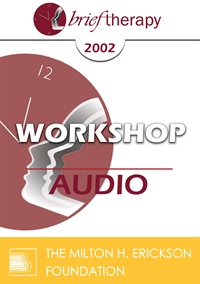
- Average Rating:
- Not yet rated
- Topic Areas:
- Workshops | Brief Therapy | Ericksonian Hypnosis and Therapy Techniques | Psychotherapy | Resources | Self-Relations
- Categories:
- Brief Therapy Conference | Brief Therapy Conference 2002
- Faculty:
- Stephen Gilligan, PhD
- Duration:
- 2:26:58
- Format:
- Audio Only
- Original Program Date:
- Dec 12, 2002
- Short Description:
- A key idea in Milton Erickson's work was that a person's problematic experiences and behaviors can be skillfully accepted and utilized as the basis for therapeutic change. Self-relations psychotherapy develops this idea further, emphasizing symptoms as indicating the death of an old identity and the impending birth of a new identity. In this workshop, we will see how a therapist can generate a ritual space where symptoms and other disturbing experiences can be "midwifed" into new identities.
- Price:
- $15.00 - Base Price
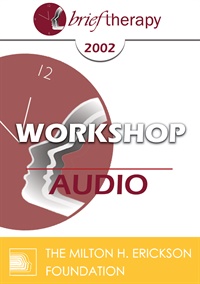
- Average Rating:
- Not yet rated
- Topic Areas:
- Workshops | Brief Therapy | Therapeutic Relationship | Therapist Development
- Categories:
- Brief Therapy Conference | Brief Therapy Conference 2002
- Faculty:
- Insoo Kim Berg, MSSW
- Duration:
- 2:20:25
- Format:
- Audio Only
- Original Program Date:
- Dec 14, 2002
- Short Description:
- BT02 Workshop 14 - Working with Mandated Clients - lnsoo Kim Berg, MSSW
- Price:
- $15.00 - Base Price
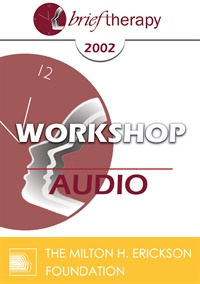
- Average Rating:
- Not yet rated
- Topic Areas:
- Workshops | Brief Therapy | Children and Adolescent Therapy | Family Therapy | Redecision Therapy
- Categories:
- Brief Therapy Conference | Brief Therapy Conference 2002
- Faculty:
- Mary Goulding, MSW
- Duration:
- 2:14:20
- Format:
- Audio Only
- Original Program Date:
- Dec 14, 2002
- Short Description:
- Volunteers from the audience will create one-act dramas and family sculptures from childhood scenes in order to understand their early decisions and make desired changes in their lives today.
- Price:
- $15.00 - Base Price
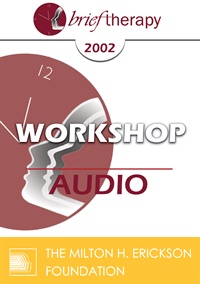
- Average Rating:
- Not yet rated
- Topic Areas:
- Workshops | Habits | Addiction | Brief Therapy | Ericksonian Hypnosis and Therapy Techniques | Tailoring
- Categories:
- Brief Therapy Conference | Brief Therapy Conference 2002
- Faculty:
- Jeffrey Zeig, PhD
- Duration:
- 2:31:23
- Format:
- Audio Only
- Original Program Date:
- Dec 14, 2002
- Short Description:
- A method will be presented for joining strategic assessment and intervention to create pattern disruption and elicit resources for change. Essentials of an Ericksonian method for tailoring approaches to habit control will be offered. Weight and smoking control will be emphasized.
- Price:
- $15.00 - Base Price
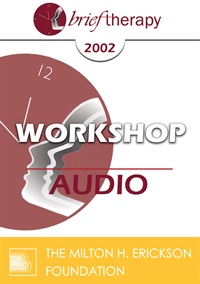
- Average Rating:
- Not yet rated
- Topic Areas:
- Workshops | Children and Adolescent Therapy | Communication | Brief Therapy
- Categories:
- Brief Therapy Conference | Brief Therapy Conference 2002
- Faculty:
- Insoo Kim Berg, MSSW
- Duration:
- 2:12:52
- Format:
- Audio Only
- Original Program Date:
- Dec 15, 2002
- Short Description:
- Working with children requires adaptations of techniques that depend on language skills. This workshop will describe useful language techniques that help to work with children briefly.
- Price:
- $15.00 - Base Price

- Average Rating:
- Not yet rated
- Topic Areas:
- Workshops | Anxiety | Depression | Happiness | Love | Relationships | Brief Therapy
- Categories:
- Brief Therapy Conference | Brief Therapy Conference 2002
- Faculty:
- Pat Love, EdD
- Duration:
- 1:40:50
- Format:
- Audio Only
- Original Program Date:
- Dec 15, 2002
- Short Description:
- To love and be loved. Sounds simple - yet for many it is one of life's most difficult challenges. Come and explore three major causes of unhappiness in relationships and gain a deeper understanding of how they are related.
- Price:
- $15.00 - Base Price
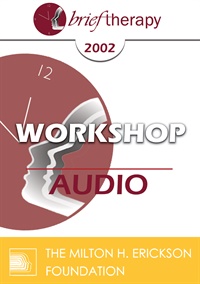
- Average Rating:
- Not yet rated
- Topic Areas:
- Workshops | Brief Therapy | Children and Adolescent Therapy | Family Therapy
- Categories:
- Brief Therapy Conference | Brief Therapy Conference 2002
- Faculty:
- Jon Carlson
- Duration:
- 2:25:07
- Format:
- Audio Only
- Original Program Date:
- Dec 15, 2002
- Short Description:
- Mental health experts are frequently called upon to work with parents and teachers. This workshop describes how most interventions are ineffective and will provide a brief procedure that works. The seven-step model will be discussed and videotaped examples will be provided.
- Price:
- $15.00 - Base Price
- Average Rating:
- Not yet rated
- Topic Areas:
- Clinical Demonstrations | Experiential Therapy | Brief Therapy | Psychotherapy
- Categories:
- Brief Therapy Conference | Brief Therapy Conference 2003
- Faculty:
- Jeffrey Zeig, PhD
- Duration:
- 51:57
- Format:
- Audio Only
- Original Program Date:
- Dec 12, 2003
- Short Description:
- Educational Objectives: 1) To list three integrative methods in the demonstration. 2) Given a patient, propose an integrative treatment plan.
- Price:
- $15.00 - Base Price
- Average Rating:
- Not yet rated
- Topic Areas:
- Clinical Demonstrations | Psychotherapy | Brief Therapy | Four-Stage Creative Process
- Categories:
- Brief Therapy Conference | Brief Therapy Conference 2003
- Faculty:
- Ernest Rossi, PhD
- Course Levels:
- Master Degree or Higher in Health-Related Field
- Duration:
- 56:37
- Format:
- Audio and Video
- Original Program Date:
- Dec 12, 2003
- Short Description:
- BT03 Clinical Demonstration 03 - Facilitating the Four-Stage Creative Process in Psychotherapy - Ernest Rossi, PhD Educational Objectives: 1) To name the essentials of a behavioral activity-dependent approach to creative work. 2) To list the four stages of the creative process in psychotherapy.
- Price:
-
Sale is $29.00
price reduced from Base Price - $59.00
- Average Rating:
- Not yet rated
- Topic Areas:
- Clinical Demonstrations | Brief Therapy | Cognitive Behavior Therapy (CBT) | Couples Therapy
- Categories:
- Brief Therapy Conference | Brief Therapy Conference 2003
- Faculty:
- Frank Dattilio, PhD, ABPP
- Course Levels:
- Master Degree or Higher in Health-Related Field
- Duration:
- 51:51
- Format:
- Audio and Video
- Original Program Date:
- Dec 12, 2003
- Short Description:
- Educational Objectives: 1) To identify maladaptive schemas and dysfunctional thoughts. 2) To describe how to integrate cognitive-behavioral skills into treatment.
- Price:
-
Sale is $29.00
price reduced from Base Price - $59.00
- Average Rating:
- Not yet rated
- Topic Areas:
- Clinical Demonstrations | Psychotherapy | Brief Therapy | Meditation, Spirituality and Yoga | Resources
- Categories:
- Brief Therapy Conference | Brief Therapy Conference 2003
- Faculty:
- Stephen Gilligan, PhD
- Course Levels:
- Master Degree or Higher in Health-Related Field
- Duration:
- 51:51
- Format:
- Audio and Video
- Original Program Date:
- Dec 12, 2003
- Short Description:
- Educational Objectives: 1) To describe how therapists can connect clients to a calm, centering inner state. 2) To describe how connection to the inner self can allow new resources and solutions to develop.
- Price:
- $59.00 - Base Price
- Average Rating:
- Not yet rated
- Topic Areas:
- Clinical Demonstrations | Attunement | Brief Therapy | Therapist Development
- Categories:
- Brief Therapy Conference | Brief Therapy Conference 2003
- Faculty:
- Pat Love, EdD
- Course Levels:
- Master Degree or Higher in Health-Related Field
- Duration:
- 52:00
- Format:
- Audio and Video
- Original Program Date:
- Dec 12, 2003
- Short Description:
- 1) To describe the clinical effectiveness of attunement. 2) Given a case, integrate the importance of attunement in clinical practice.
- Price:
-
Sale is $29.00
price reduced from Base Price - $59.00
- Average Rating:
- Not yet rated
- Topic Areas:
- Clinical Demonstrations | Solution Oriented Approach | Supervision | Brief Therapy
- Categories:
- Brief Therapy Conference | Brief Therapy Conference 2003
- Faculty:
- Yvonne Dolan, MA
- Course Levels:
- Master Degree or Higher in Health-Related Field
- Duration:
- 49:02
- Format:
- Audio and Video
- Original Program Date:
- Dec 12, 2003
- Short Description:
- Educational Objectives: 1) To identify two practical questions that are useful for solution- focused supervision. 2) To identify two criteria for maximizing therapist effectiveness through supervision.
- Price:
-
Sale is $29.00
price reduced from Base Price - $59.00
- Average Rating:
- Not yet rated
- Topic Areas:
- Clinical Demonstrations | Panic | Brief Therapy | Strategic Therapy | Anxiety
- Categories:
- Brief Therapy Conference | Brief Therapy Conference 2003
- Faculty:
- Reid Wilson, PhD
- Course Levels:
- Master Degree or Higher in Health-Related Field
- Duration:
- 1:00:14
- Format:
- Audio and Video
- Original Program Date:
- Dec 12, 2003
- Short Description:
- In this clinical demonstration, a client struggling with escalator and highway driving fears learns to confront anxiety through structured exposure. Emphasizing frequency, duration, and intensity, the session outlines 45-minute practice sessions to build habituation. Anxiety is reframed as a training opportunity, and a point system is introduced to boost motivation and help the client face fears with purpose and persistence.
- Price:
-
Sale is $29.00
price reduced from Base Price - $59.00
- Average Rating:
- Not yet rated
- Topic Areas:
- Clinical Demonstrations | Belief Systems | Brief Therapy
- Categories:
- Brief Therapy Conference | Brief Therapy Conference 2003
- Faculty:
- Robert Dilts, BA
- Course Levels:
- Master Degree or Higher in Health-Related Field
- Duration:
- 1:02:04
- Format:
- Audio and Video
- Original Program Date:
- Dec 12, 2003
- Short Description:
- Educational Objectives: 1) To describe one method to help clients develop new perspectives with respect to limiting beliefs and assumptions. 2) To describe how to lead clients to reflect on themselves from different time frames and perceptual positions.
- Price:
-
Sale is $29.00
price reduced from Base Price - $59.00
Tags: Belief Systems Brief Therapy
- Average Rating:
- Not yet rated
- Topic Areas:
- Clinical Demonstrations | Pain and Healing | Brief Therapy | Hypnosis | Trance
- Categories:
- Brief Therapy Conference | Brief Therapy Conference 2003
- Faculty:
- Stephen Lankton, MSW
- Course Levels:
- Master Degree or Higher in Health-Related Field
- Duration:
- 59:27
- Format:
- Audio and Video
- Original Program Date:
- Dec 12, 2003
- Short Description:
- Educational Objectives: 1) To describe the use of three trance phenomena in the reduction of pain. 2) To describe how hypnosis for pain control can be introduced in brief therapy.
- Price:
-
Sale is $29.00
price reduced from Base Price - $59.00
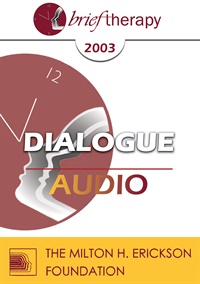
- Average Rating:
- Not yet rated
- Topic Areas:
- Dialogues | Brief Therapy | Self-Care | Therapist Development
- Categories:
- Brief Therapy Conference | Brief Therapy Conference 2003
- Faculty:
- Mary Goulding, MSW | John C. Norcross, PhD
- Duration:
- 52:52
- Format:
- Audio Only
- Original Program Date:
- Dec 12, 2003
- Short Description:
- BT03 Dialogue 01 - Therapist Self-Care - Mary Goulding, MSW, John Norcross, PhD
- Price:
- $15.00 - Base Price
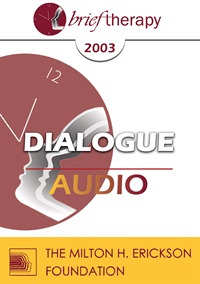
- Average Rating:
- Not yet rated
- Topic Areas:
- Dialogues | Brief Therapy
- Categories:
- Brief Therapy Conference | Brief Therapy Conference 2003
- Faculty:
- Robert Dilts, BA | Stephen Gilligan, PhD
- Duration:
- 53:18
- Format:
- Audio Only
- Original Program Date:
- Dec 12, 2003
- Short Description:
- Educational Objective: To become aware of the differing approaches to brief therapy and to describe the strengths and weaknesses in each approach.
- Price:
- $15.00 - Base Price
Tags: Brief Therapy
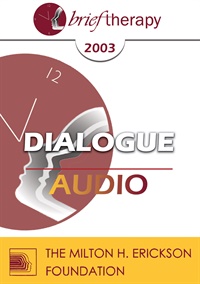
- Average Rating:
- Not yet rated
- Topic Areas:
- Dialogues | Brief Therapy | Therapist Development
- Categories:
- Brief Therapy Conference | Brief Therapy Conference 2003
- Faculty:
- Jon Carlson | William Glasser, MD
- Duration:
- 53:18
- Format:
- Audio Only
- Original Program Date:
- Dec 12, 2003
- Short Description:
- Educational Objectives: To become aware of the differing approaches to brief therapy and to describe the strengths and weaknesses in each approach.
- Price:
- $15.00 - Base Price
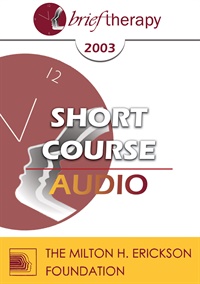
- Average Rating:
- Not yet rated
- Topic Areas:
- Short Courses | Addiction | Brief Therapy | Psychotherapy | Abuse | Motivation | Personality Disorders
- Categories:
- Brief Therapy Conference | Brief Therapy Conference 2003
- Faculty:
- Ralph Armstrong, MD
- Duration:
- 1:37:13
- Format:
- Audio Only
- Original Program Date:
- Dec 13, 2003
- Short Description:
- Motivation is crucial to successful recovery from Substance Use Disorders. Fifteen DSM IV conditions reduce the motivation needed to bond with programs that assist in abstinence. Child abuse and neglect are frequent in substance abusers, and a conceptualization of its role in substance abuse is given. Therapy for sequelae such as schizoid personality, resentment, pessimism and others are described. with treatment of Axis I and II disorders accomplished, and the effects of abuse/neglect allayed, involvement with 12 step programs is more likely.
- Price:
- $15.00 - Base Price
- Average Rating:
- Not yet rated
- Topic Areas:
- Clinical Demonstrations | Experiential Therapy | Hypnotherapy | Brief Therapy | Psychotherapy
- Categories:
- Brief Therapy Conference | Brief Therapy Conference 2006
- Faculty:
- Jeffrey Zeig, PhD
- Course Levels:
- Master Degree or Higher in Health-Related Field
- Duration:
- 55:46
- Format:
- Audio and Video
- Original Program Date:
- Dec 08, 2006
- Short Description:
- BT06 Clinical Demonstration 01 - Experiential Hypnotherapy - Jeffrey Zeig, PhD
- Price:
-
Sale is $29.00
price reduced from Base Price - $59.00



